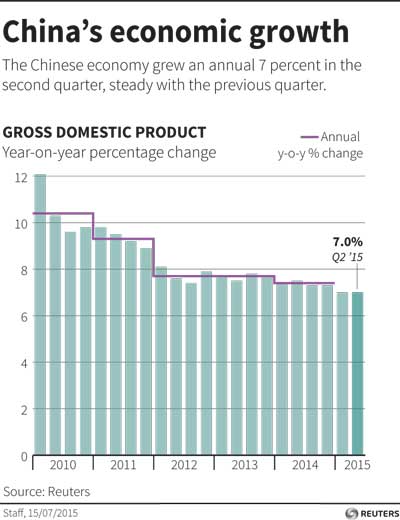Tuesday Dec 09, 2025
Tuesday Dec 09, 2025
Thursday, 16 July 2015 00:00 - - {{hitsCtrl.values.hits}}

Reuters: China’s economy grew an annual 7% in the second quarter, steady with the previous quarter and slightly better than analysts’ forecasts, though further stimulus is still expected after the quarter ended with a stock market crash.
Monthly activity data, released alongside the GDP report, also beat expectations across the board to show signs of a rebound, with factory output hitting a five-month high, following reports of increased bank lending on Tuesday.
It has been a difficult year for the world’s second-largest economy. Slowing growth in trade, investment and domestic demand has been compounded by a cooling property sector, deflationary pressure, and the recent equity market panic, so signs of improvement may help buttress faltering investor confidence in the effectiveness of Beijing’s management.
Beijing will still need to provide liquidity to buttress its still-rickety stock exchanges – which the statistics bureau described as key to economic stability – and to reduce the cost of corporate financing, which remains far higher than returns on investment for many companies.
Economists have also called for more direct fiscal stimulus to help support local governments as they grapple with a mountain of debt.
Fiscal expenditure rose 13.9% on an annual basis in June, a sharp rise from May’s low 2.6% but well below April’s 33.2% spike.
The surprisingly positive readings have some analysts questioning the accuracy of official data, suggesting they are more about reassuring investors than true reflections of performance. For example, June power output only increased 0.5% year-on-year, even though factory output climbed 6.8%.
The National Bureau of Statistics rejected suggestions that figures were being inflated.
It is not only the government reporting a warmer second quarter; the recent independent China Beige Book survey also reported signs of a broad-based recovery for the period, which it said was largely driven by growth in the interior provinces.
“While actual growth is almost certainly a percentage point or two slower than the official figures show, there are good reasons to think that the latest figures are mirroring a genuine stabilisation,” wrote Julian Evans-Pritchard, economist at Capital Economics in Singapore.
“There is growing evidence of an improvement in the wider economy.”
More pain, more gain
The statistics bureau described the recovery as ‘hard won’ and noted it was driven primarily by an increase in domestic consumption, which produced 60% of China’s economic growth in the first half, compared with 35.7% for capital formation and 4.3% from net exports.
Consumption contributed 51.2% to GDP growth in 2014, so the rise will be welcomed by a government that is trying to reduce its dependence on exports in favour of domestic demand.
The statistics bureau warned that the nascent recovery required more support to consolidate.
“We must also take note that domestic and the external economic environment remains complex, and the global economic recovery is tortuous and slow,” it said.
Even so, bureau spokesman Sheng Laiyun predicted further improvements in the second half as previous policy measures, including several interest rate cuts, take effect.
Andrew Colquhoun of Fitch Ratings also expects an improvement in the rest of the year.
“The resilience of retail sales in June is a further encouraging sign that downside risk, while not negligible, is receding, despite recent equity-market volatility.”
Credit questions
Data on Tuesday showed bank lending increased sharply in June, thanks to central bank support.
However, economists worry that many companies and individuals borrowed heavily to buy stocks in the first half, so the sharp stock market decline – when many companies suspended their stocks from trading, locking up shares used as collateral – could inhibit banks’ ability to lend.
Stock markets have stabilised since the central bank began serving as indirect buyer of last resort, but sharp rallies last week were not sustained this week.
Chinese stock markets did not celebrate the growth figures, with benchmark indexes down more than 2%.
Before the market plunged in June, key indexes had risen nearly 60% in the first half, which some economists estimate added more than a percentage point to total GDP growth in that period, mostly by boosting activity in the financial services sector.
If that boost peters out now the market appears to have run out of steam, it could drag on third-quarter figures.
The government has forecast economic growth of around 7% for 2015, which would be the weakest rate in 25 years.